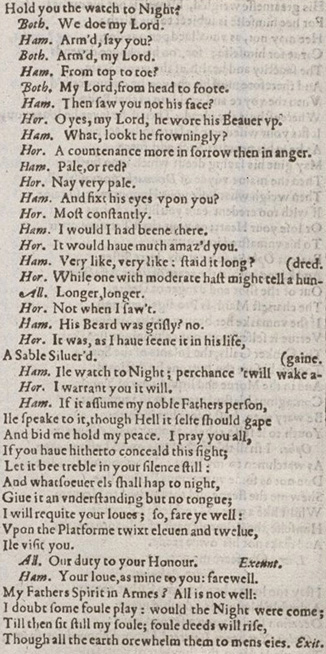
Physicalizing the Spiritual
One of the things which marks out the scene in this staging from more typical approaches is its physicality. The customary distance between father and son which can be seen in filmic versions (in the movies by Olivier, Zeffirelli and Branagh, for example) here becomes a carefully choreographed and intimate embrace, the actors almost always touching, however much that touch might be mediated by the shroud fabric (a recurrent motif throughout the production). Much of this startlingly physical depiction grows out of both the desire to enact the kind of relationship described above, and a way to use the physical body of the actor and the limits of the theatrical space to somehow describe the spiritual presence of the ghost.
|
CLIP 6 |
CLIP 7 |
|
The actor John Ammerman describes a very loving relationship between father and son in Hamlet. Look at the passage below from the earlier scene in which Hamlet has just heard from Horatio about his father's ghost upon the ramparts. What do Hamlet's questions suggest about the relationship between father and son? What lines might lend support to Ammerman's understanding of the relationship? What lines might suggest a different interpretation? |

|
How does the physicality between father and son in the Georgia Festival interpretation's of Hamlet compare to what you have seen in other versions of the play? Olivier? BBC? Zeffirelli? Branagh? If you were to stage the play, would you play this scene in the loving, close way described in this section? |
|
CLIP 8 |
CLIP 9 |
|
Does the Ghost's material always function to connect the two actors? Does the connection between them always seem affectionate? This is a play in which clothing is repeatedly foregrounded -- from Hamlet's attire in the opening council scene, to the concern of a character like Osric for his appearance, through Ophelia's "garments" that pull her to her "muddy death." Even the Ghost's attire is noted in the famous Q1 stage direction from the closet scene:
What do you make of the play's many allusions to clothing? What do they tell us about the world of the play and the concerns of the people in that world? |
* * * * *